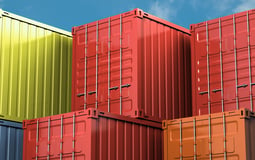Protect Your Supply Chain from this Fire Now
Keith LaBotz - October 28, 2021

How to Extinguish Supply Chain Volatility like a Firefighter
The first rain of the season is special. The smell of rain soaking the pavement and the patter on my windows brings a bonus this year - the end of a devastating wildfire season here in California.
If only Mother Nature could douse the wildfire ravaging the global supply chain. There may be no visible flames, but supply chain volatility behaves like wildfire, and it can destroy the economy if we don’t extinguish it.
Are you up to learning how to fight this fire?
Invisible Supply Chain Wildfire
Volatility has kept supply chains in crisis mode for 18 months. Recently, images of port congestion became a media poster, and while alarming, it’s only a tiny fraction of the larger wildfire hidden from public view. The size of this fire is impossible to gauge right now, and here’s why:
- There are no visible flames; volatility is seen within each enterprise as interruptions to workflow and eventually reflected on the corporate balance sheet.
- Major disruptions manifest as a series of smaller global disruptions in countless businesses.
How do you fight an invisible fire? You’ll need visibility. Yes. That was a dad-joke, but it’s also the right response.
Supply Chain FireFighting
While we don’t see any flames from volatility, we do see firefighting. Fighting supply chain volatility and battling wildfires share many of the same challenges:
-
Victories are short-lived, and there’s no end in sight.
-
When a fire flares up, sparks ignite new fires, which do the same.
-
Burned-out areas appear extinguished but flare up again.
-
Every fire is urgent and important, making priorities increasingly difficult to manage.
-
Operations are unsustainable; it’s only a matter of time until resources deplete.
-
Frustration, fatigue, and complacency decrease effectiveness over time.
Supply Chain Fires Inflict Greater Damage
Certain features make the supply chain wildfire more damaging than those which burn down forests. Understanding these differences can help you understand the risks your business must manage.
-
Fire spreads instantly around the world to stakeholders in your supply chain.
-
No matter how successful your company is in extinguishing fires, it is at the mercy of its trading partners who pass their fires onto your business. Choose your supply chain partners wisely!
-
Mitigating disruptions requires additional processing and communications.
-
Mitigation may involve improvisation or performing steps outside of standard procedures, increasing the likelihood of errors and more disruptions.
-
The velocity of cash, data, and materials slow down in the supply chain - jeopardizing resources needed to sustain the firefight.
-
A backlog of unresolved issues often builds until a breaking point is reached, dumping fuel into the fire.
-
Prioritization becomes more difficult as problems accrue, diminishing productivity and allowing high-impact problems to escalate. A fatal cycle of declining productivity can ensue.
Firefighting Math
Protecting your company from volatility depends on: (1) how many fires pass from the supply chain into your enterprise and; (2) how effective your response is to these fires. Time is of the essence in firefighting:
-
Fires grow exponentially, so damage, containment costs, and risk of failure all expand with the fire.
-
It’s crucial to prioritize issues on potential impact (cost).
-
It only takes one fire to get out of control - all bets are off once your business can no longer contain a fire.
Does this sound like a case for increasing supply chain visibility? It is, and even improving enterprises visibility will make your business more resilient. The quickest path for increasing supply chain visibility is integrating shipping and receiving processes with transportation carriers.
-
Adopt a transportation-centric supply chain model and focus on shipping.
-
Consider a supply chain visibility platform that’s strong in transportation to reduce implementation time.
-
A dynamic routing engine is one of the best things a company can do to gain visibility of last-mile delivery and streamline internal fleet operations.
What in the Blazes is Going On?
The bullwhip and network effect in supply chains can exponentially increase volatility even if downtime is brief. With each passing hour of downtime, systemic damages compound for a network. Resynchronizing a large network like the global supply chain could become impossible if left inoperable for too long.
Lockdowns amassed devastating levels of damage, and this ignited the supply chain wildfire. No amount of intervention can reverse the disruption that’s baked into the supply chain. Supply chains must become more resilient, minimizing volatility risk and increasing optimization through visibility.
How the Wildfire Ends
Volatility is a symptom of system failure, and we are watching the supply chain, the world’s economic engine, struggle to survive a crippling blow. I think the network will recover, but it may take years, and the cost will be huge. Equal to the cost of the systemic damages. The fire will go out once this bill is paid in full.
Who Pays and How
We will pay those bills. Governments pay for nothing - they merely spend what we earn from the economic engine. The sooner we douse the flames with supply chain visibility, the sooner we pay their bills. There are two payment options:
-
A recession or depression depletes global wealth. Governments may kick the can down the road to avoid shrinking and civil disorder, further reducing our wealth with massive stimulus or quantitative easing.
-
Increased productivity offsets the amount owed. We can do this by increasing supply chain efficiencies through process improvements.
Option 2 is right up our alley. Those who pursue option two will prosper going forward, and everyone else will benefit as a result.
Conclusion
I think we’re onto something with the firefighting analogy. If not, then it was a fun thought experiment. Supply chain volatility is here to stay, and your business can protect itself by increasing visibility. It’s time for your business to solve the Supply Chain 4.0 riddle.
The only thing left to figure out is how to stop the government from spending so much of our money.
Click below to download our guide on "The Route to Logistics 4.0"
LATEST POSTS
- Understand Why Production Planning Needs Specialized Solutions
- Understand Circular Economy in The Manufacturing Industry
- How Can Industry 4.0 IT Integration Be Achieved Smoothly?
- The Significance of Order Sequencing in Discrete Manufacturing
- How to improve your Supply Chain Management: The Power of Control Towers



